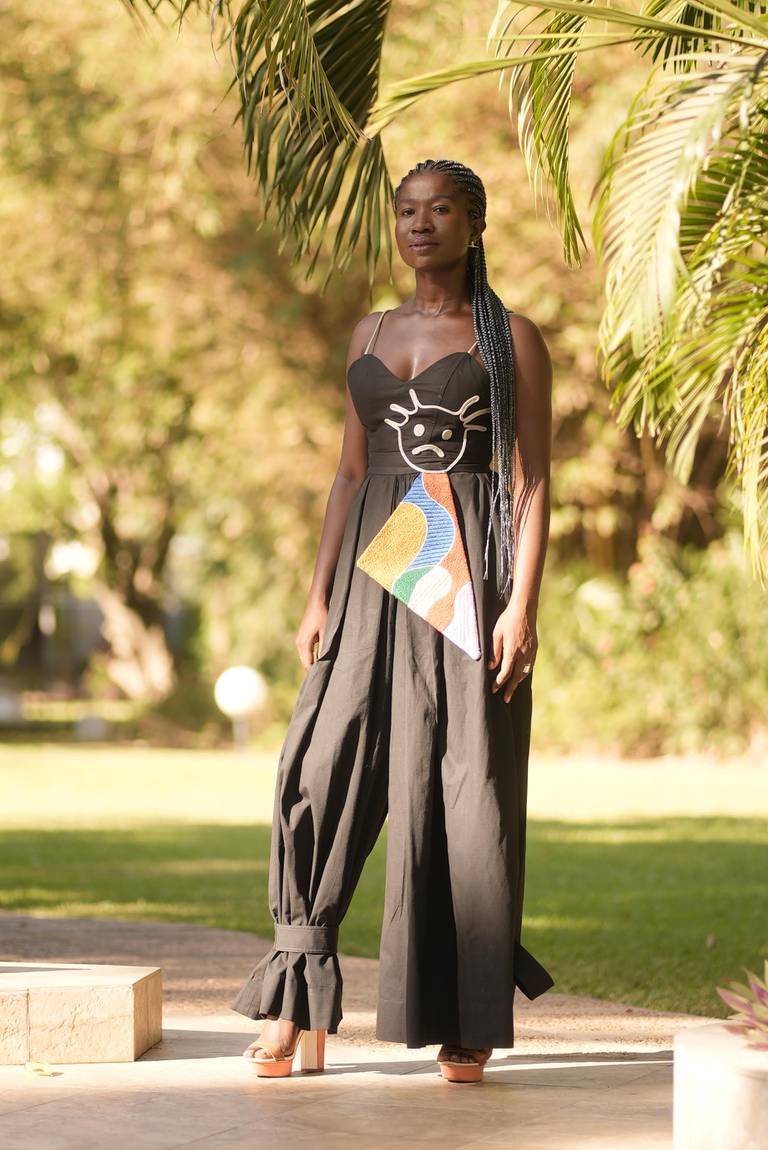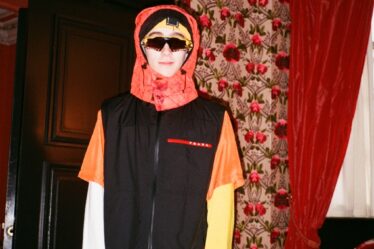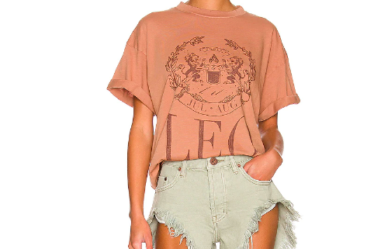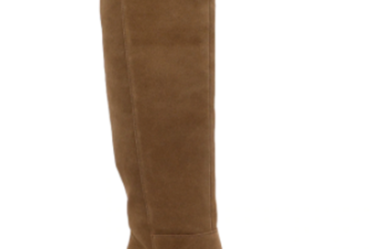
When Adeju Thompson, founder of the Nigerian label Lagos Space Programme, was looking for inspiration for their next collection, they landed on a Yoruba phrase: Aṣọ Lànkí, Kí Ató Ki Ènìyàn, which translates to “we greet [a] dress before we greet its wearer.”
This collection’s cotton fabrics in striking shades of blue and gender-bending silhouettes encapsulate ideas of cultural workwear and Yoruba masquerades, the important cultural figures regularly seen in scary, bold and flamboyant costumes. The fabrics themselves were printed in the style of Adire, a traditional Yoruba resist-dying technique using indigo dye.
Thompson sees their designs as a vessel for exploring Yoruba history, and how the ideas of gender identity and queerness have manifested in the culture. They then translate to an increasingly international audience: since its founding in 2018, Lagos Space Programme has received writeups by Vogue.com and CNN, among others.
“I think it’s definitely important to fuse my culture into my work because I think Africa has largely been overlooked,” Thompson said. “I have a huge customer base in the US which is why it is essential to me that I educate my audience about my culture in a way that they can understand.”
Thompson is part of a wave of African fashion designers who are rising on the global stage. In 2019, Thebe Magugu was crowned as the first African winner of the LVMH Prize, and Lukhanyo Mdingi, Kenneth Ize and Sindiso Khumalo, as well as Thompson, were semi-finalists and finalists within the past 3 years. Last June, Ize was named the first Black collaborator for the Karl Lagerfeld brand, and the collection launched a few weeks ago. Maxivive, a Nigerian androgynous label made its Milan fashion week debut earlier this year.
Interest in African designers has surged in the aftermath of George Floyd’s killing, which forced a reckoning in the fashion industry about a lack of Black representation. Many department stores and brands have signed Aurora James’ 15 Percent Pledge, which requires stores to commit shelf space to Black-owned brands. Over the last year, Ize and Magugu have seen their earned media value, a measure of social media engagement, more than double, according to data trackers Tribe Dynamics.
I always say that Africa is possibly the last frontier for new ideas, because everyone has mined everything everywhere else.
The pledge highlighted how Black fashion is still underrepresented within the industry. It also showed how long-ignored regions and cultures could trigger a burst of innovation when brought into the fashion mainstream.
“I always say that Africa is possibly the last frontier for new ideas, because everyone has mined everything everywhere else,” said Niyi Okuboyejo, a lecturer at Parsons School of Design and founder of Nigerian menswear label Post Imperial.
The African Media Boom
The increased visibility of African fashion is happening alongside the international success of African entertainment. Nigeria’s film industry — known as Nollywood — and globally recognised musicians are giving the continent’s fashion a cool factor, especially among younger consumers, which previous generations of designers weren’t able to tap into.
Nollywood movies, with stars wearing the latest fashions from Lagos, Abidjan, Dakar and Johannesburg, can now be seen across popular movie streaming platforms such as Netflix and Amazon Prime Video, and in cinemas across the globe. Nigerian music star Burna Boy wore an outfit from Tokyo James, a Nigerian luxury label, to the 2020 Grammy Awards, leading to increased consumer interest and more requests from celebrities to wear the label, James said.
This success has come despite African designers lacking many of the resources available to their counterparts in European and American fashion capitals. Across much of Africa, designers must contend with issues ranging from unpredictable electricity supply, limited shipping infrastructure and volatile currencies, which makes it difficult to predict the cost of producing a collection.
Arise Fashion Week in Nigeria and South African Fashion Week provide platforms for local designers. A growing number are in the running for international prizes, and can take advantage of programmes like the British Fashion Council’s International Fashion Showcase, which brings designers from around the world to London to exhibit their work.
These channels were created to nurture homegrown talent who were ready to expand across borders, but lacked the opportunity to do so.
“What the African fashion industry is doing is like what Nollywood did. It was started from the grassroots, individuals got behind it and now Nollywood is a top film industry in the world,” said Pinaman Owusu-Banahene, a veteran of African fashion who is preparing to launch ADJOAA (Africa Design Journey through Australasia), a multi-brand e-commerce platform.
Finding a Market
Magugu, Ize and James are available through international retailers such as Dover Street Market, Farfetch and Browns. However, this isn’t the case for most brands from the region, who rely on sales from their own e-commerce stores and small local boutiques.
Owusu-Banahene said in an email that she created ADJOAA to spotlight and elevate designers of African descent by creating channels that connect brands to global consumers. She plans to create channels that will allow for dissemination of relevant information about the continent, its people, design and crafts. This will partially be done through a digital conversation series where designers and key players in the industry can build discussions around African production practices and designs.
“It’s beyond fashion, there is a narrative within the cultural craftsmanship heritage in Africa,” she said. ADJOAA stocks brands including Brian Kivuti, Atto Tetteh, Tug Kenya and Maliko.
I want to help in making sure that people are putting a higher value… and consideration when it comes to shopping as they would European brands.
ADJOAA joins a growing group of e-commerce platforms created to grow African fashion. Founded by Amira Rasool in 2017, The Folklore is another multi-brand e-commerce platform with a mission to supply luxury goods from Africa and the diaspora to the global fashion market.
“I want to help in making sure that people are putting a higher value on these brands, and that they’re giving them the same respect and consideration when it comes to shopping as they would European brands,” she said.
It is also a platform that gives designers and creatives a voice to share their stories and talents. The site has a podcast, a blog and videos where designers share their stories and talk about their work.
“We try not to tell their stories at all; we let the designers tell their stories,” she said.
Many African designers are benefiting from growing interest in sustainable and second-hand fashion.
Clothing in Africa is rarely thrown away, and is passed down from generation to generation. According to a report by Oxfam in 2005, over one third of consumers in sub-Saharan Africa wear second-hand clothing, including 95 percent of Ghanaians. This is partly due to financial limitations, but it is also made possible by the craftsmanship that goes into the production of local clothing, which is made to last.
The younger generation of African creatives is pushing this conversation. Lagos Space Programme educates consumers about their sustainable dyeing techniques, the same dyeing techniques that have been long standing traditions amongst cultural communities within the continent.
“All my dyeing is done using organic indigo from dried leaves,” Thompson said. “It’s just more ethical and responsible as opposed to using chemicals that are very harmful to your body and harmful to the environment.”
As fashion slowly continues to embrace creativity from across the globe, there remains a valuable opportunity for African creatives to tell their stories at a time when their values coincide with the values of Gen-Z consumers.
“Even though we still have a long way to go to catch up with the West, we’ve got something different to offer,” said Owusu-Banahene. “The world is moving towards sustainability and slow production, it is what is in demand. I think we just need the mediums to tell these stories.”
Odunayo Ojo is a fellow at The Business of Fashion.
Related Articles:



